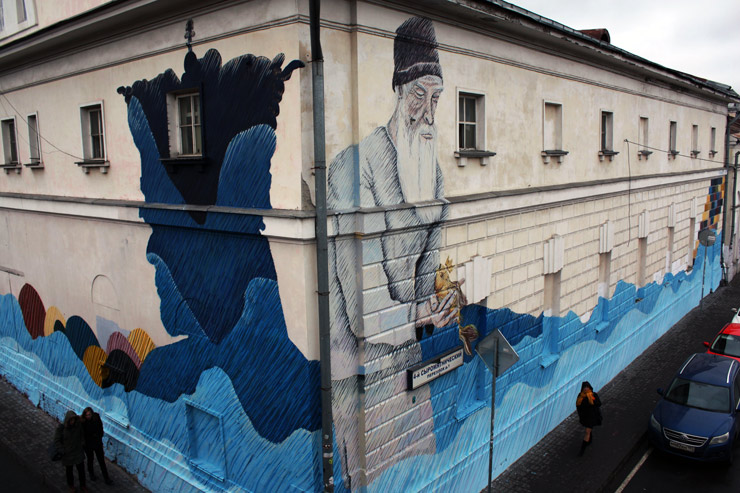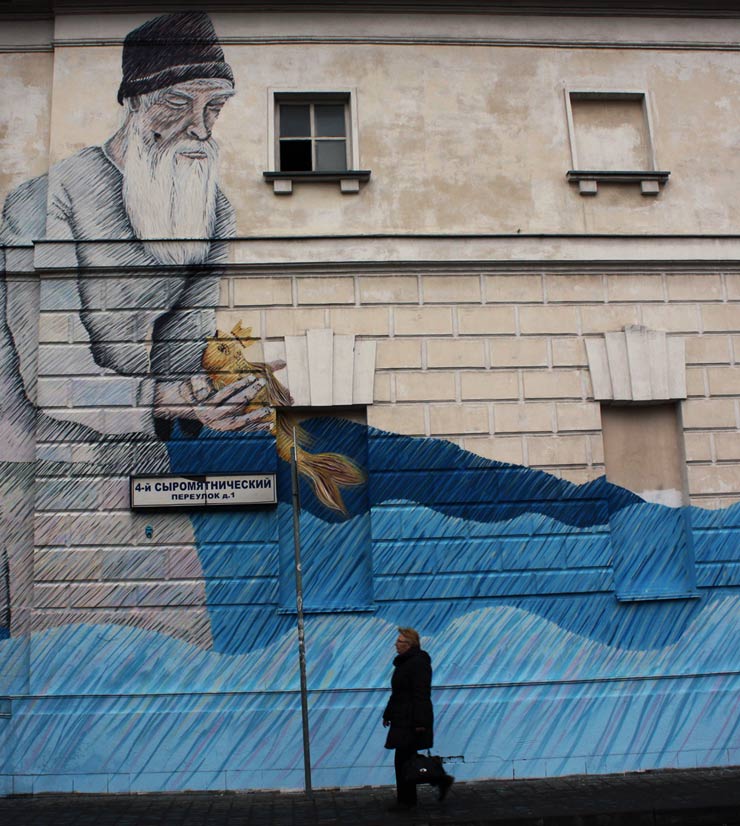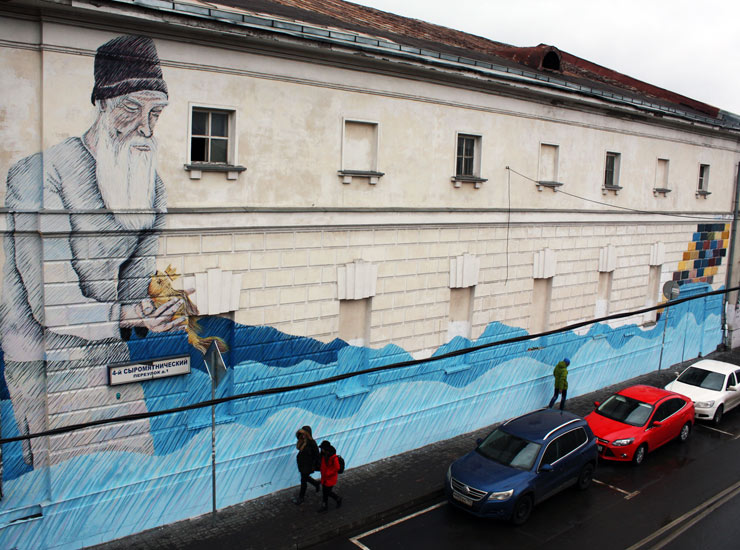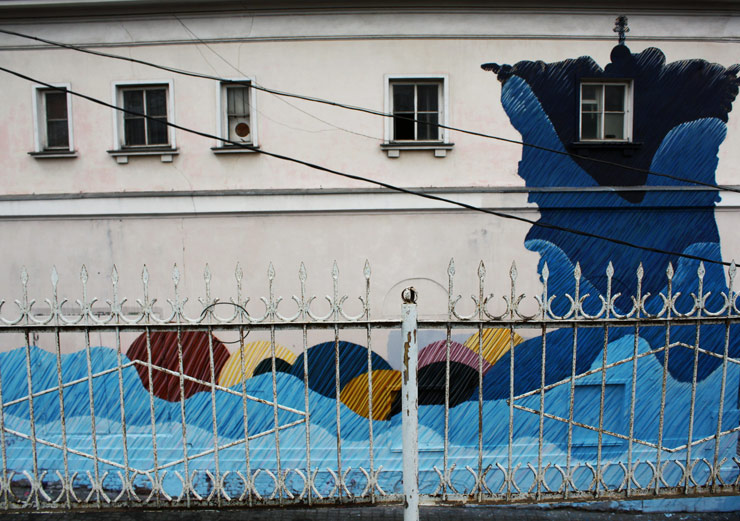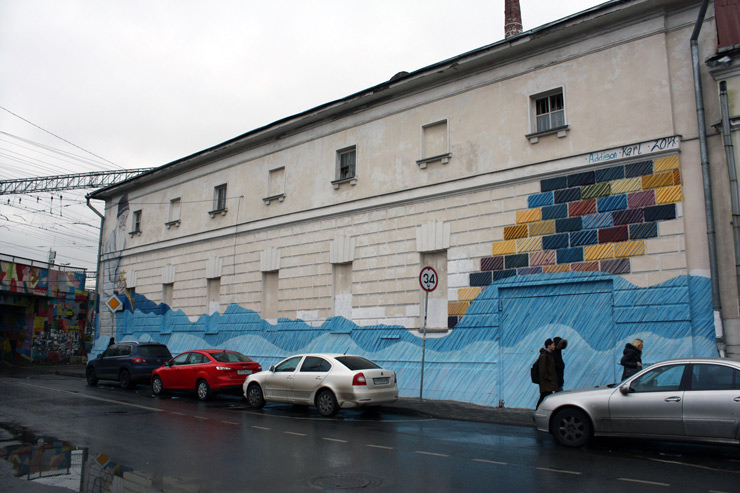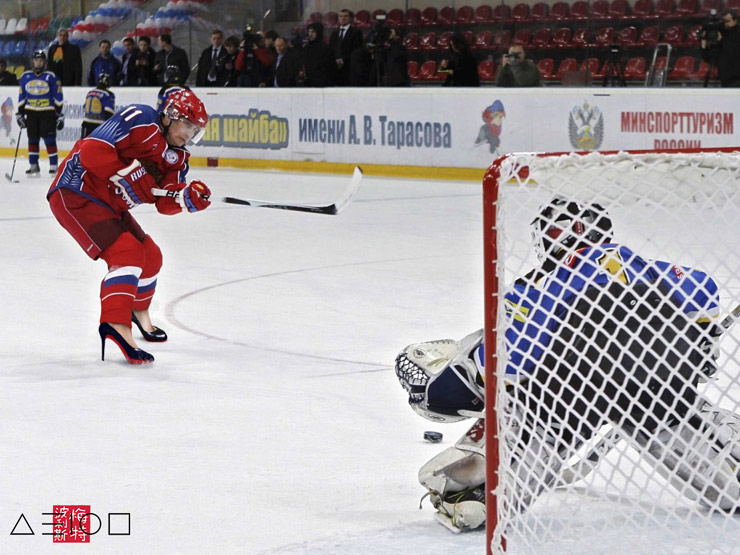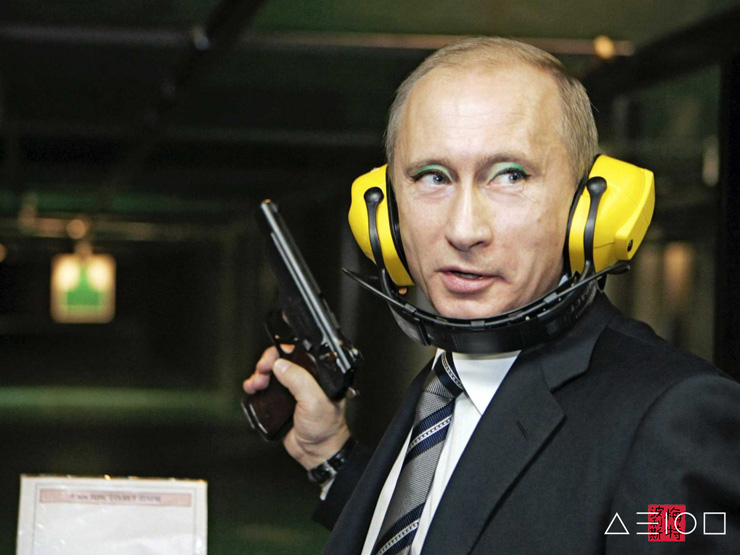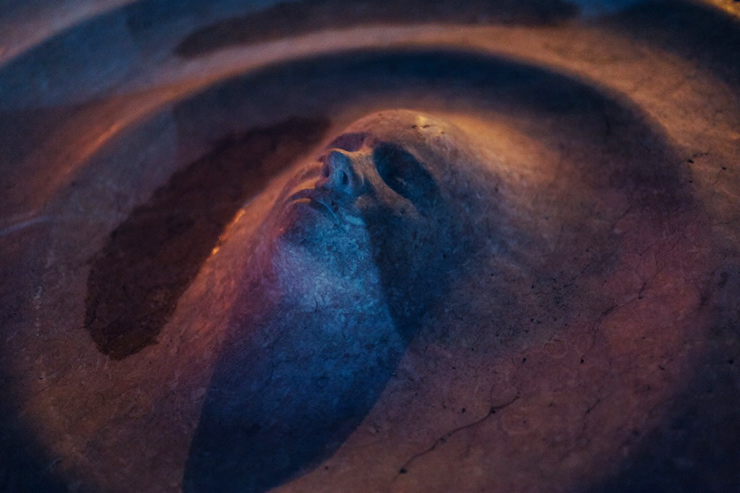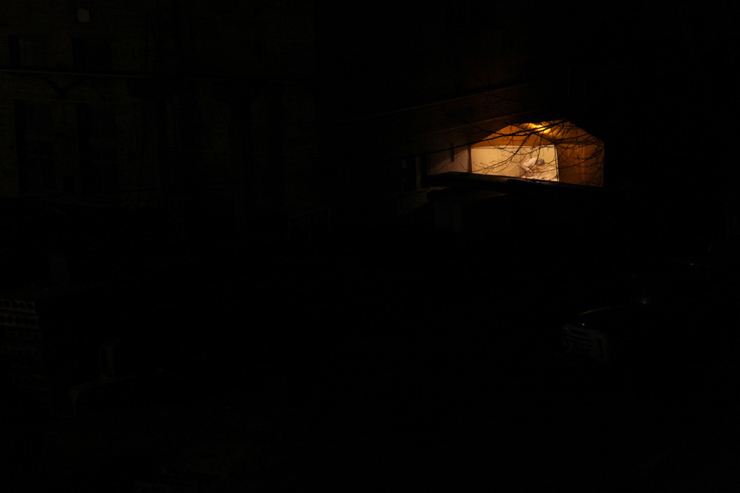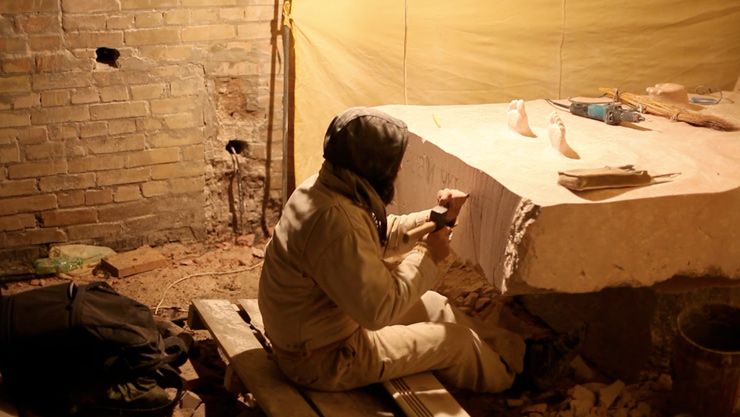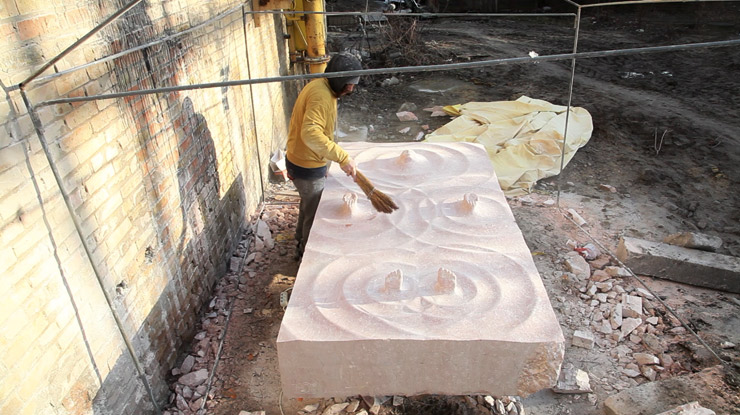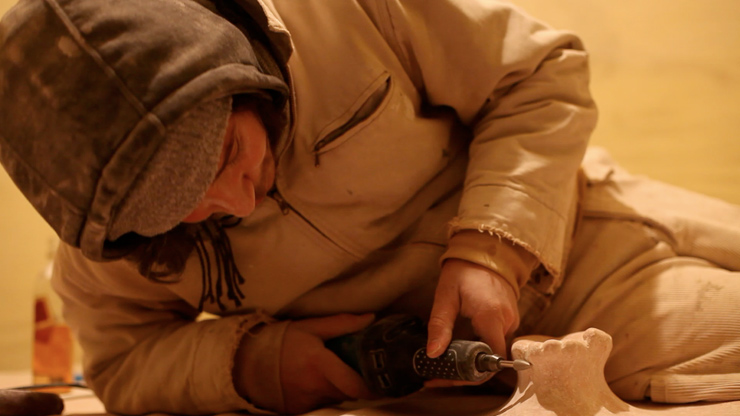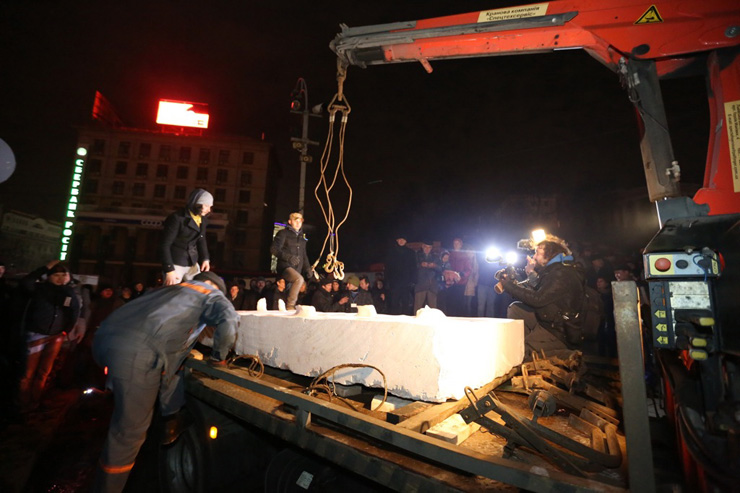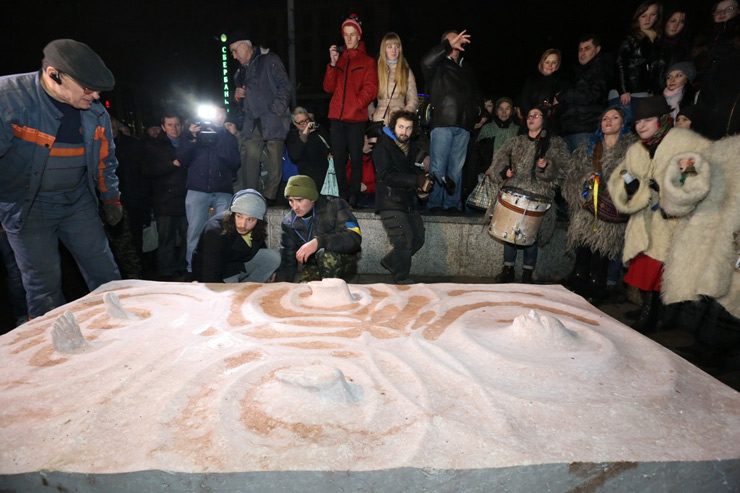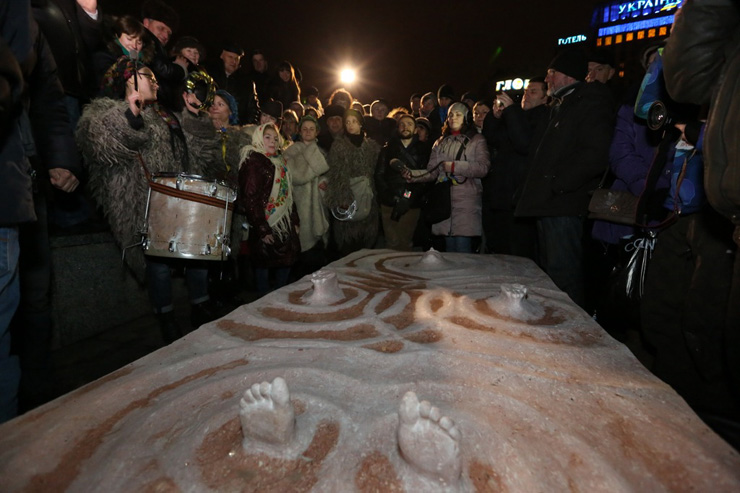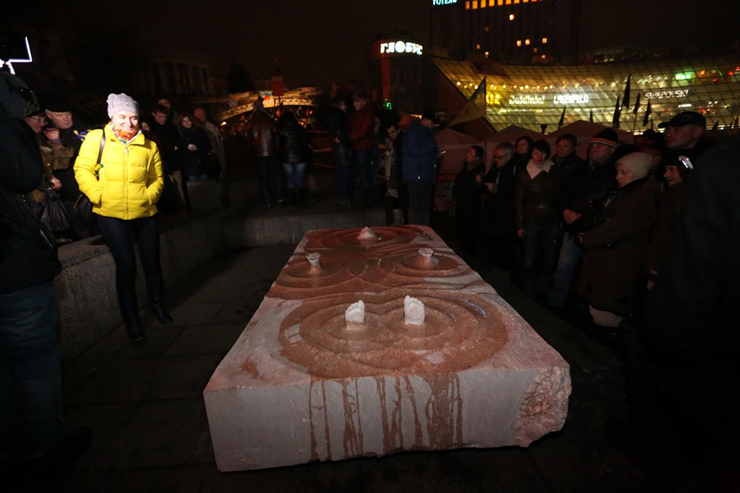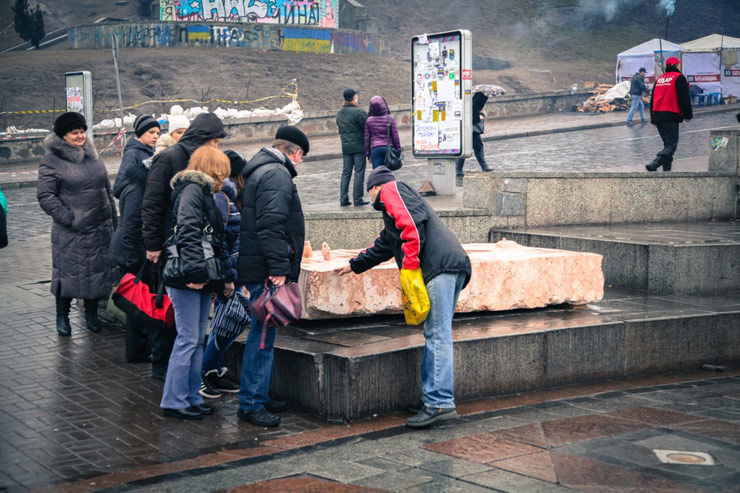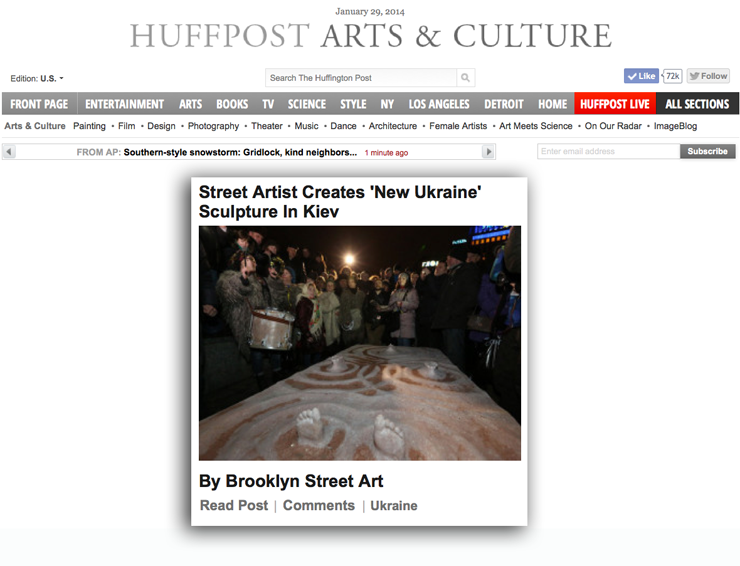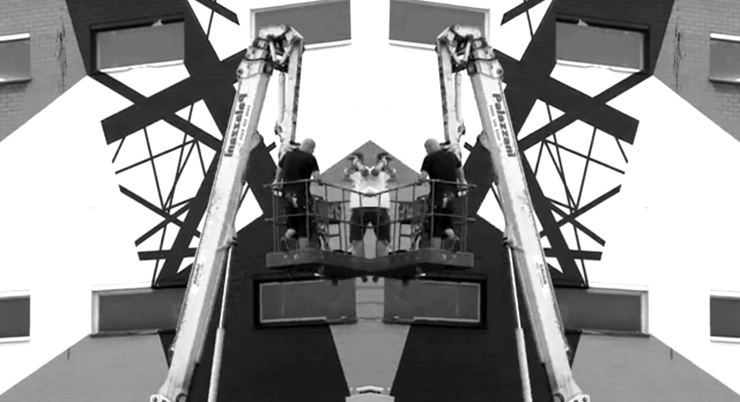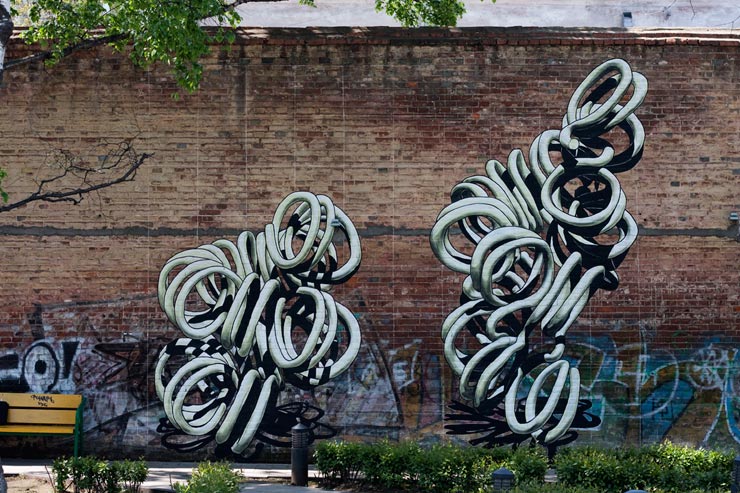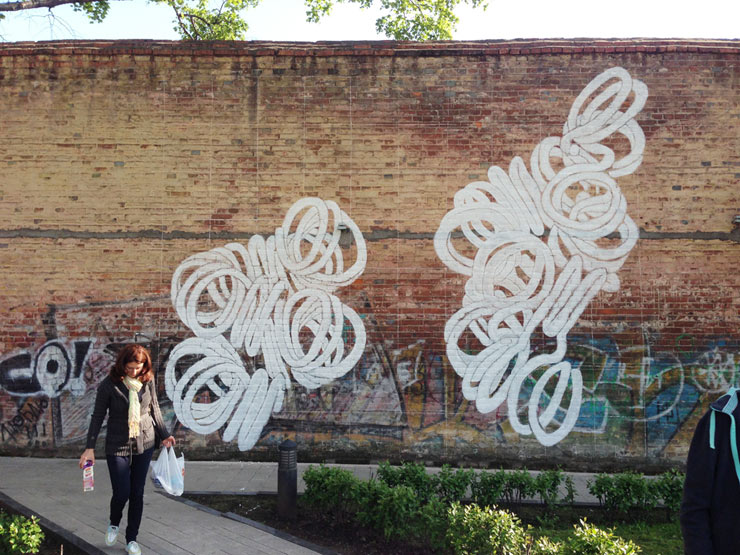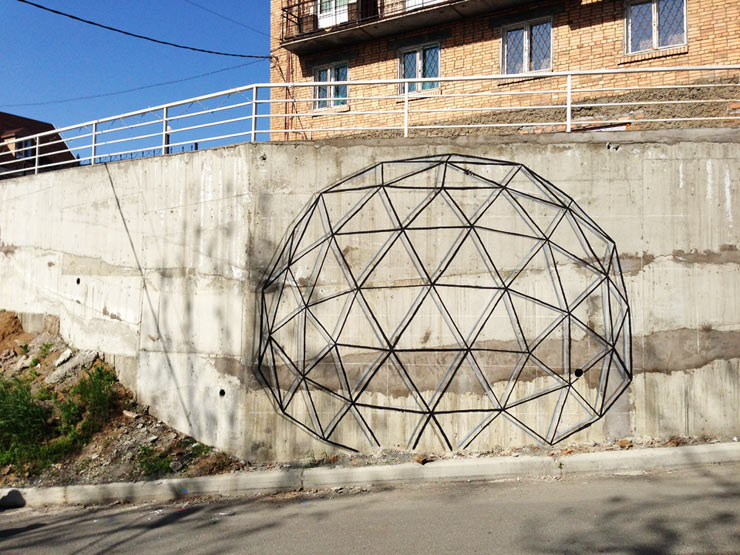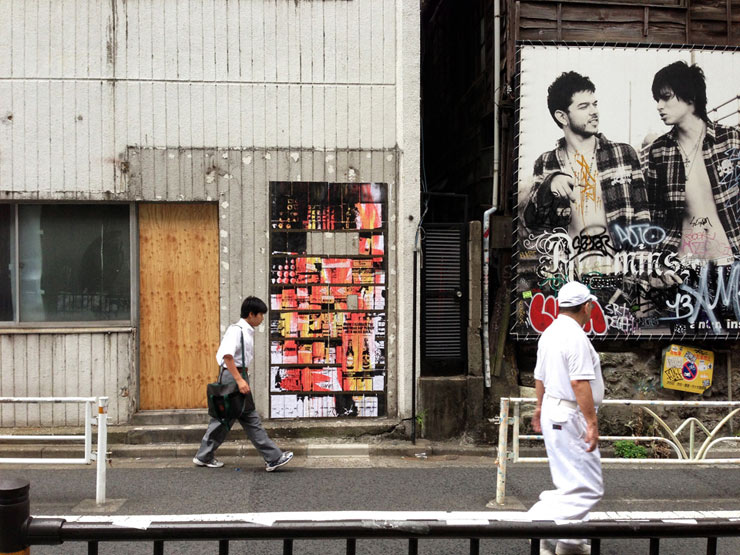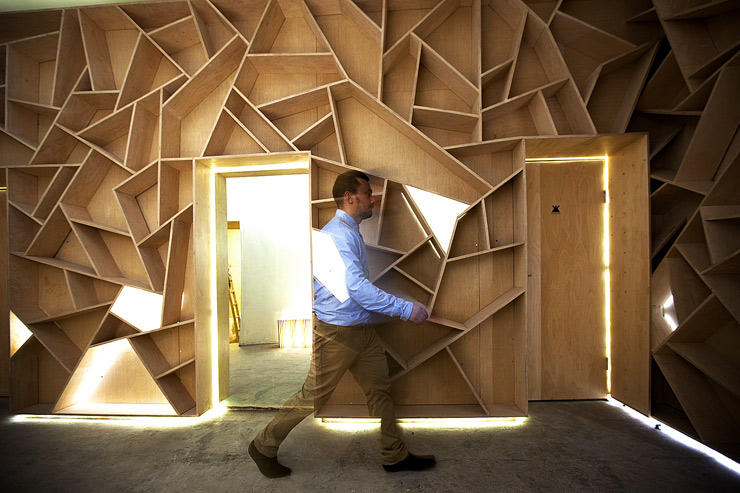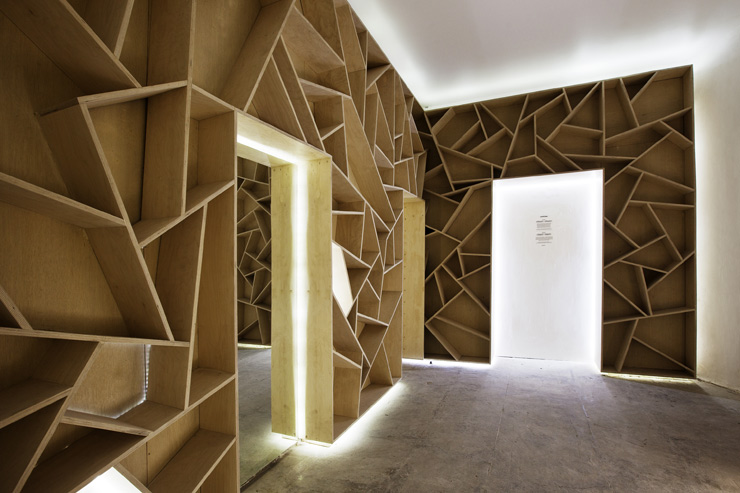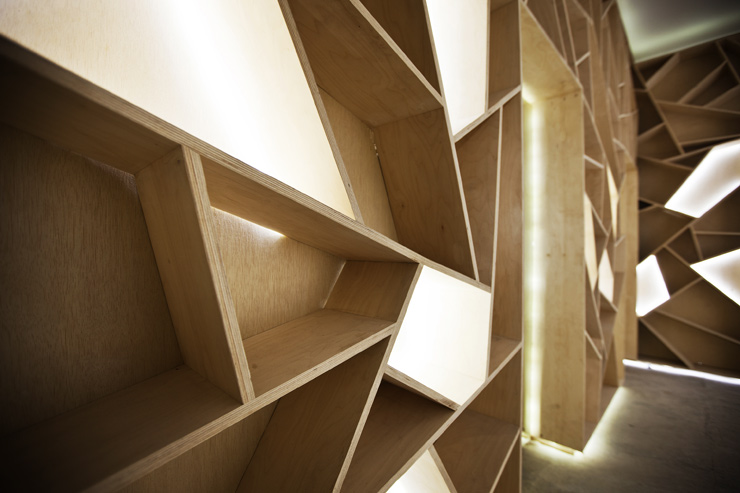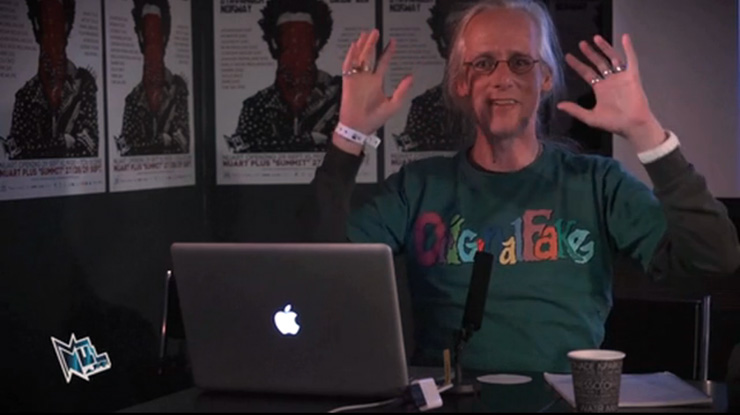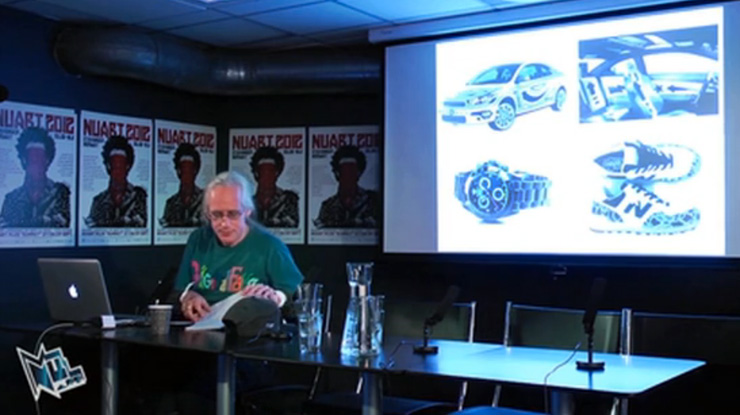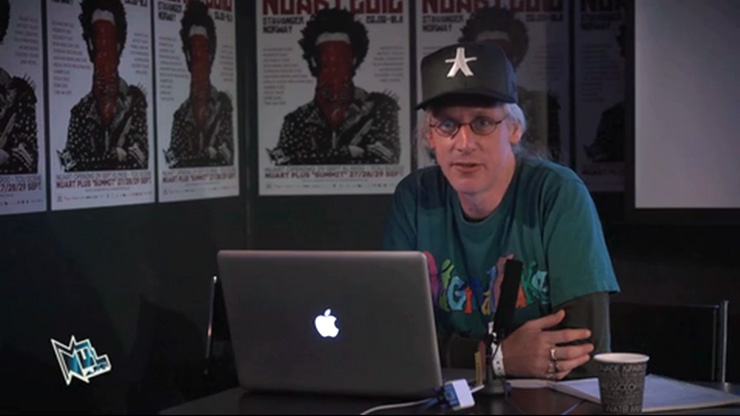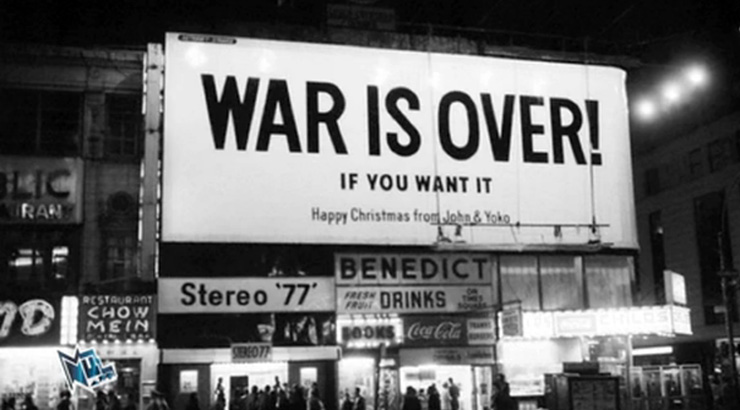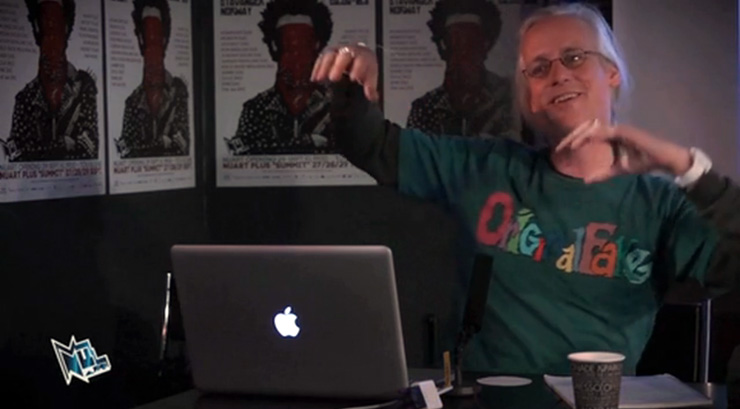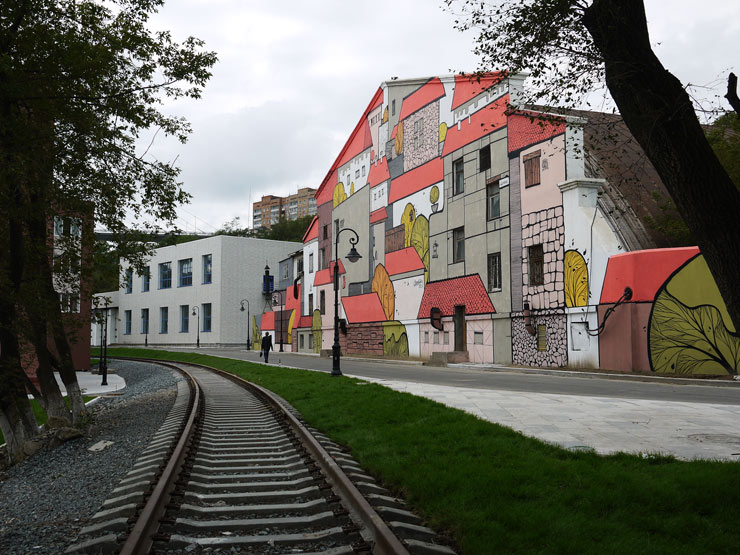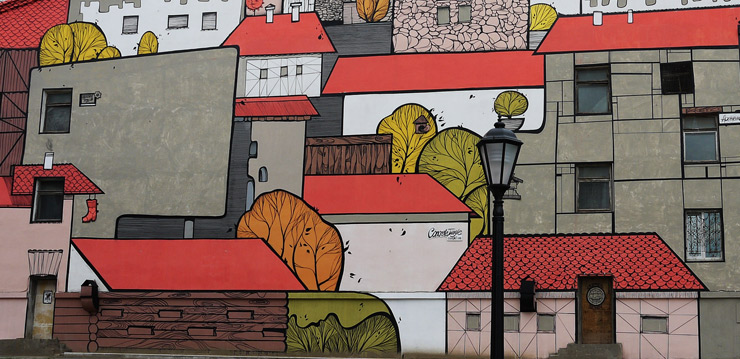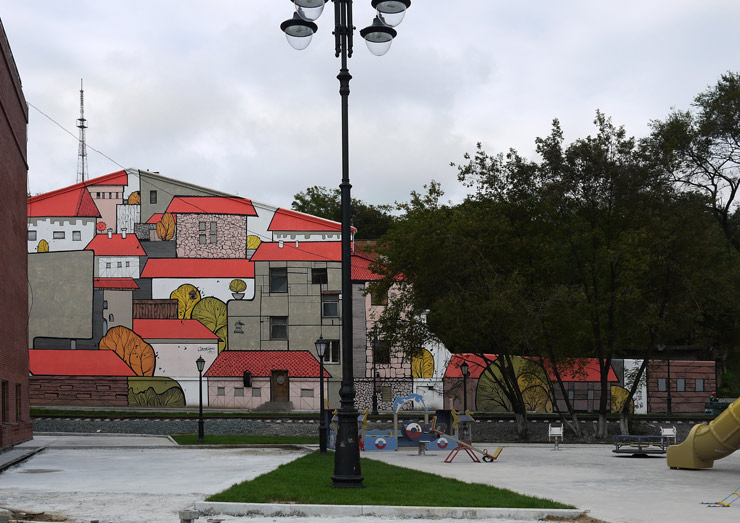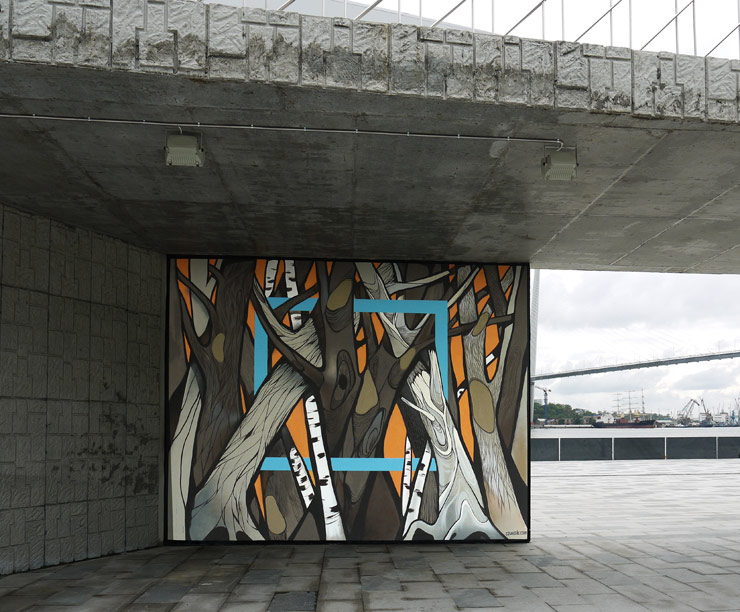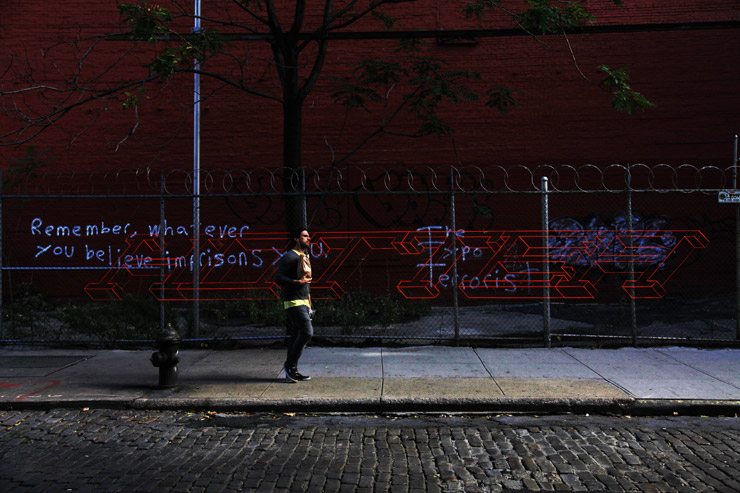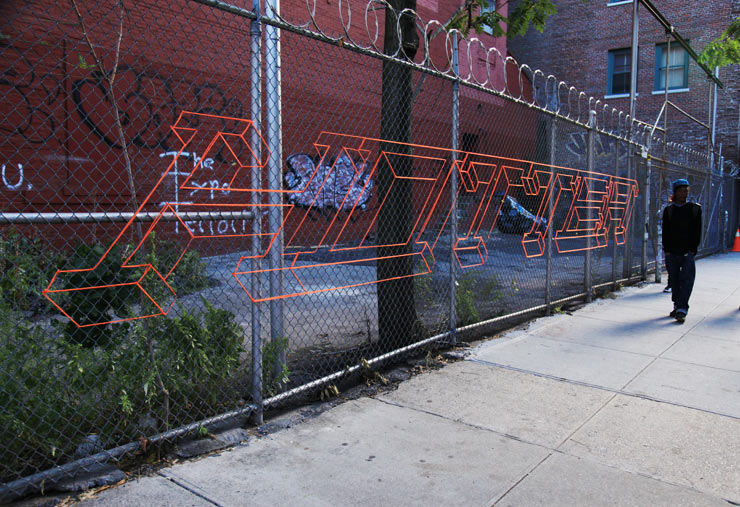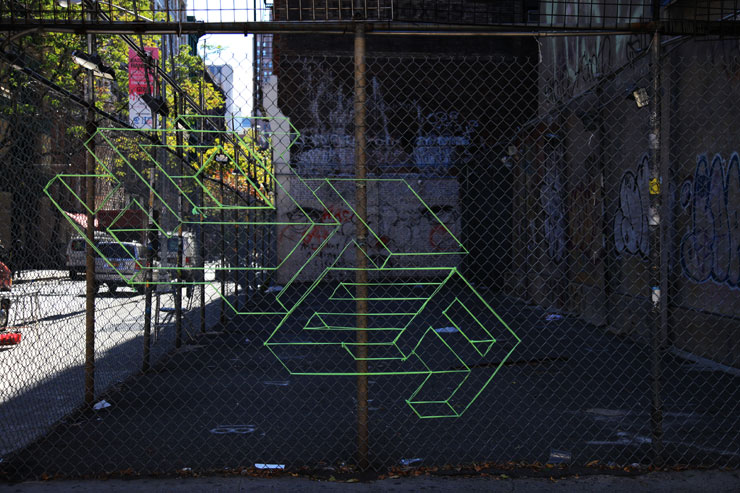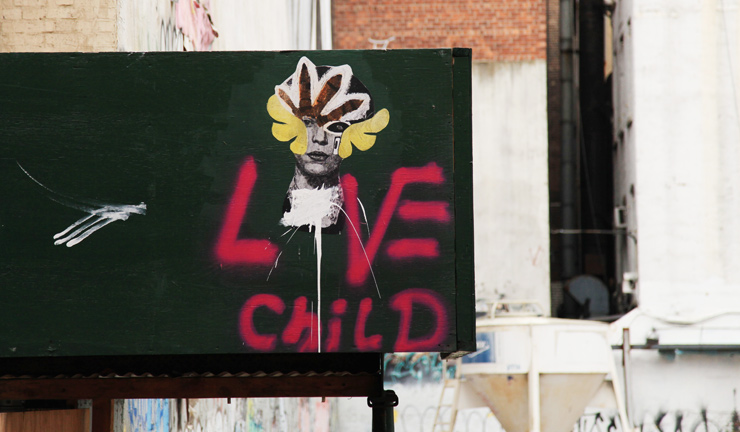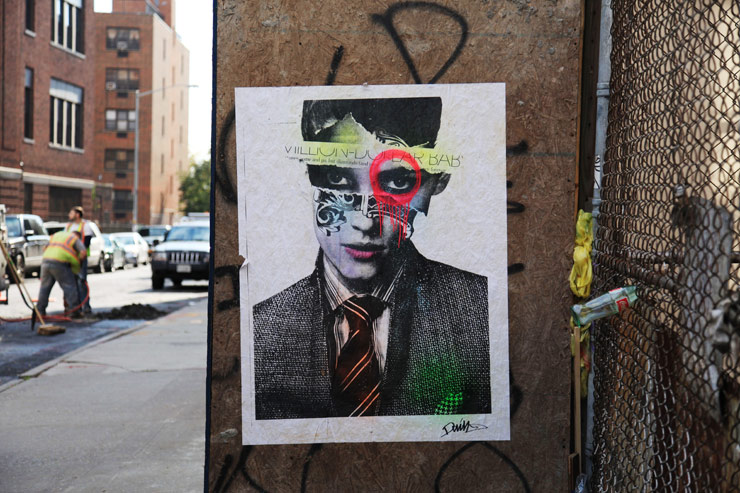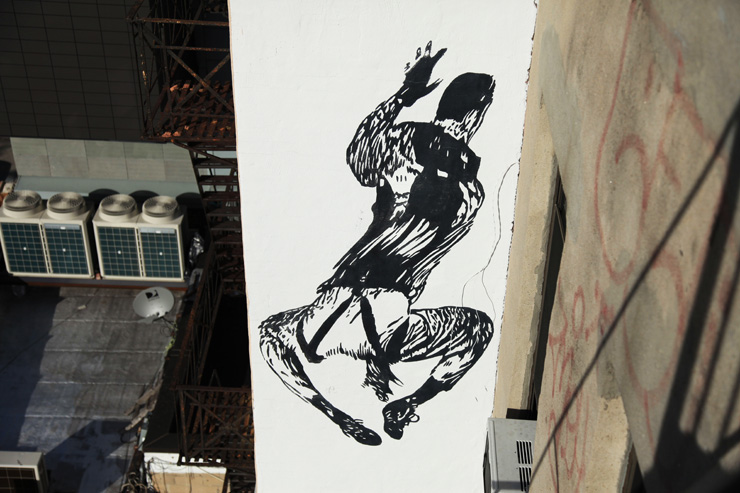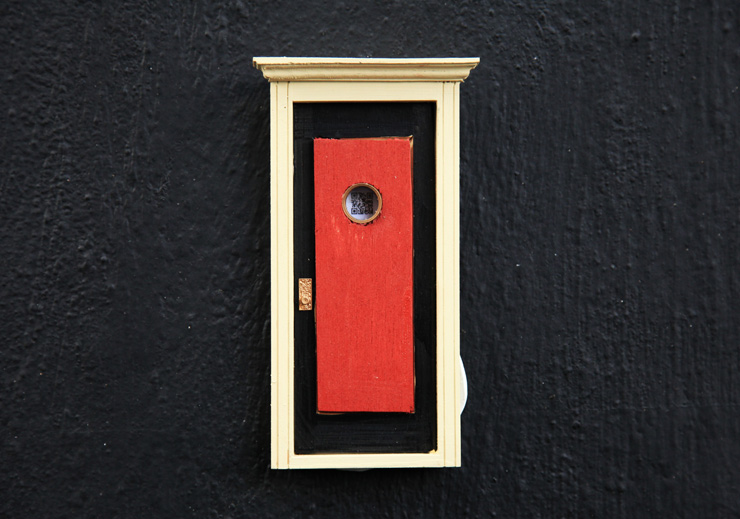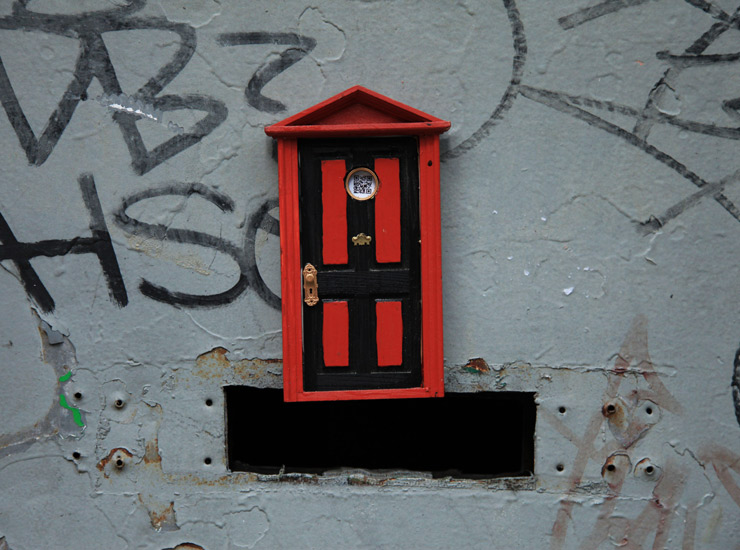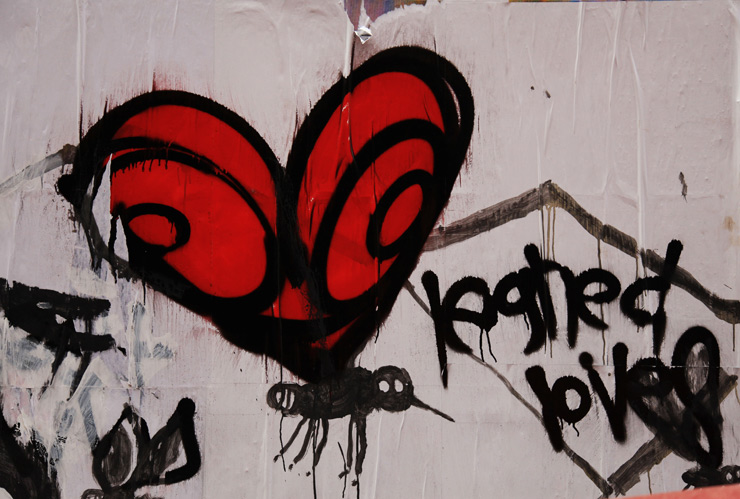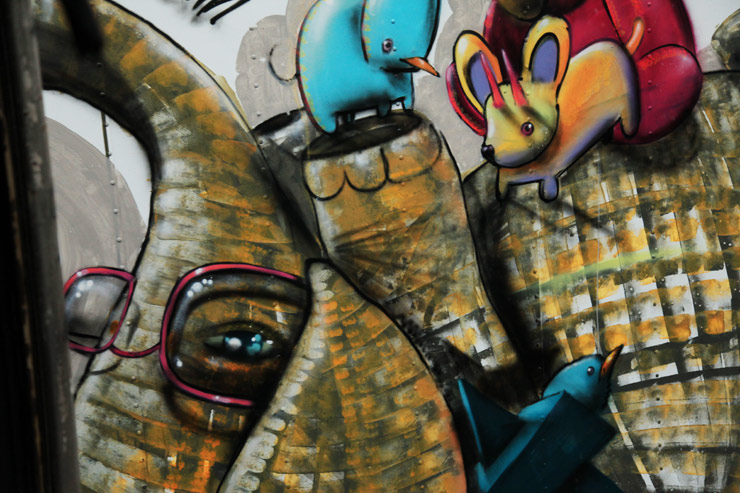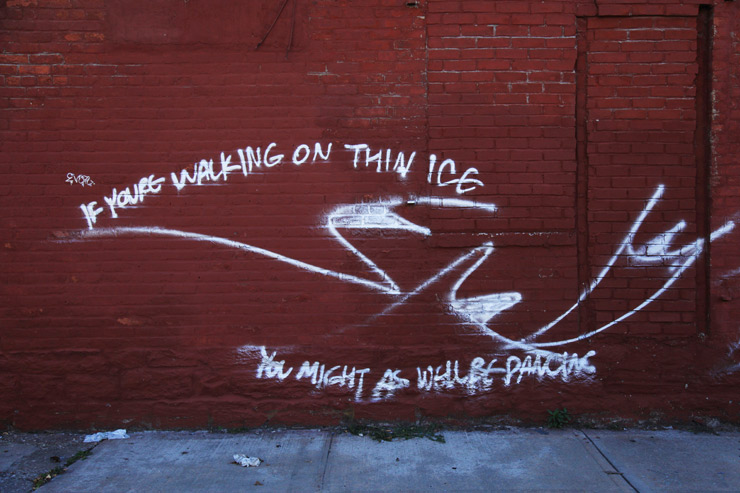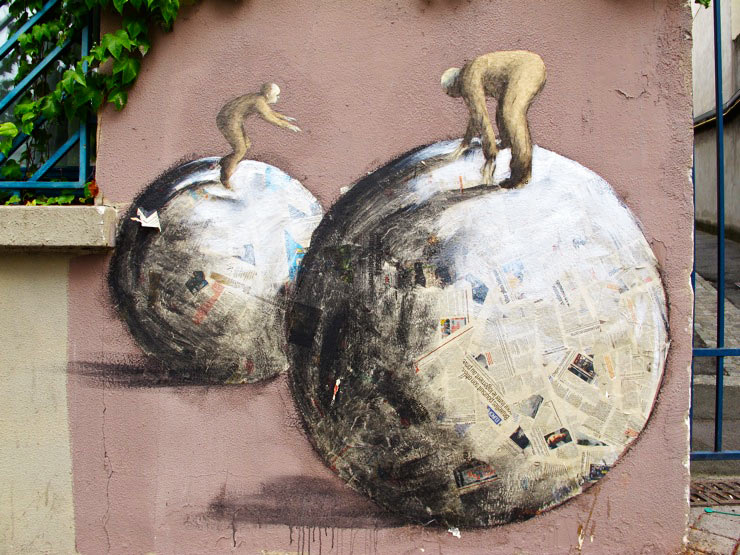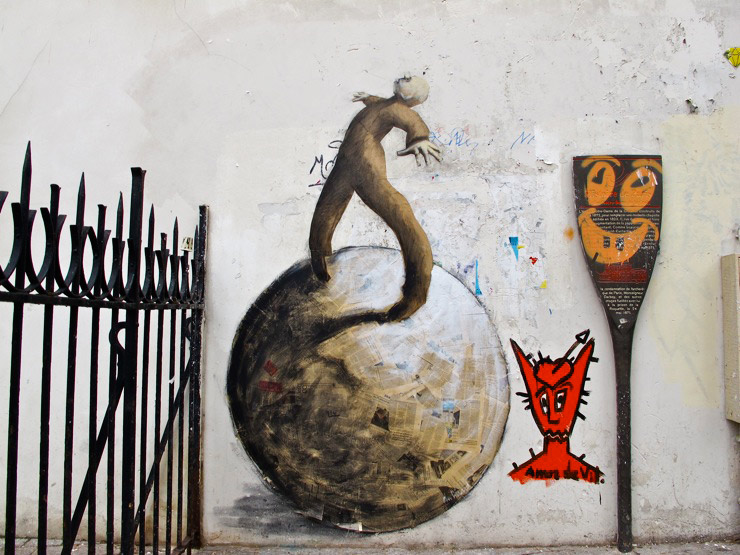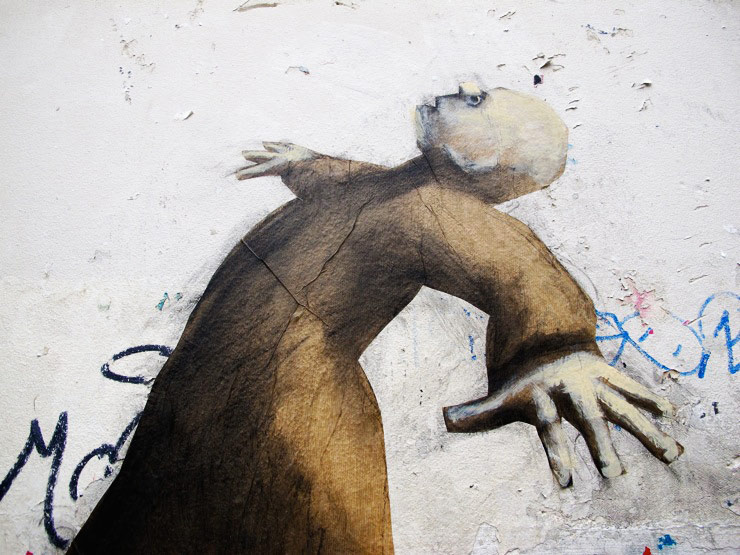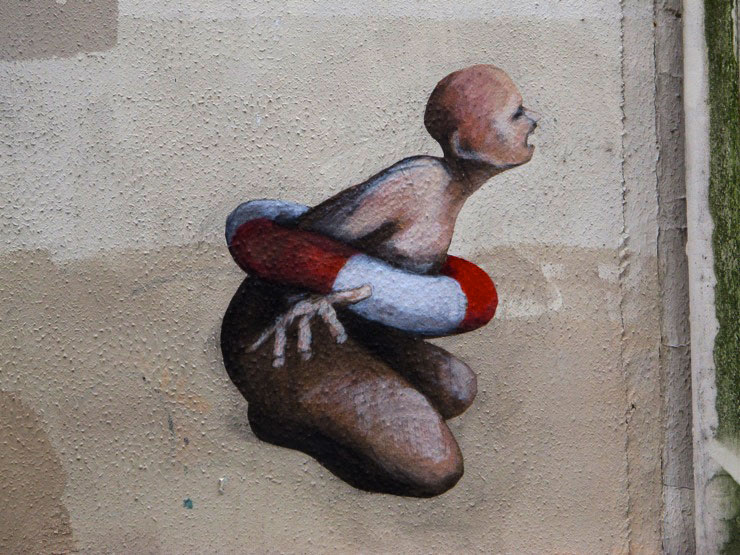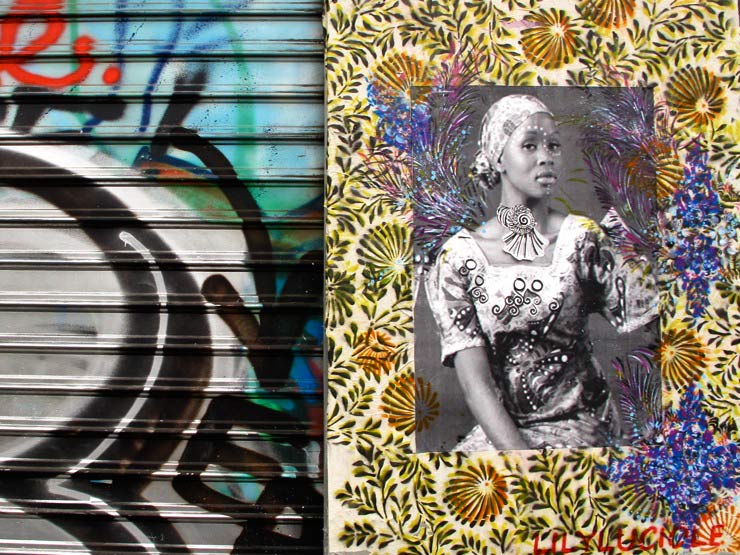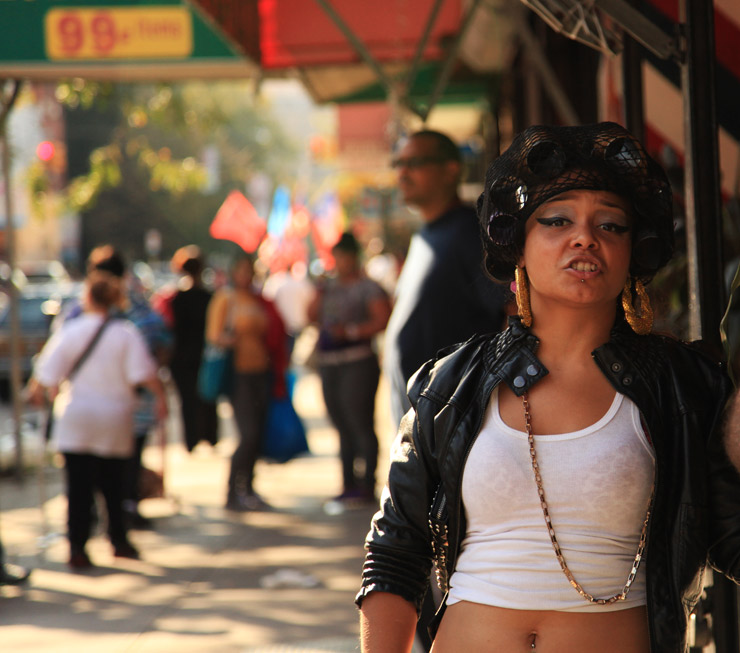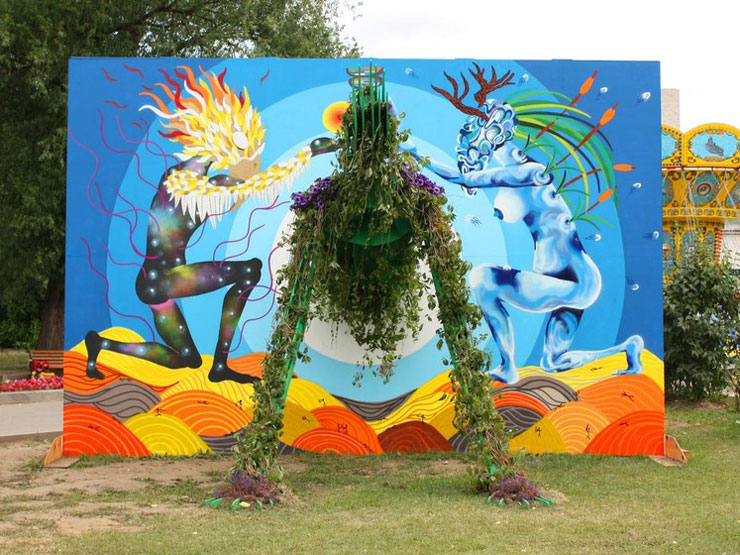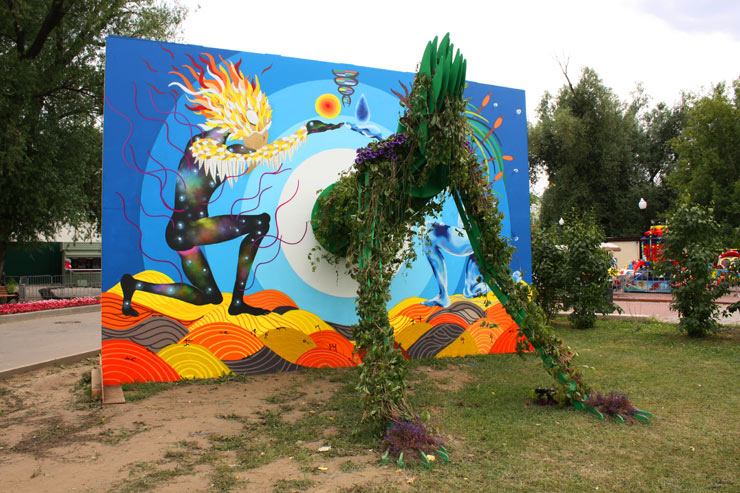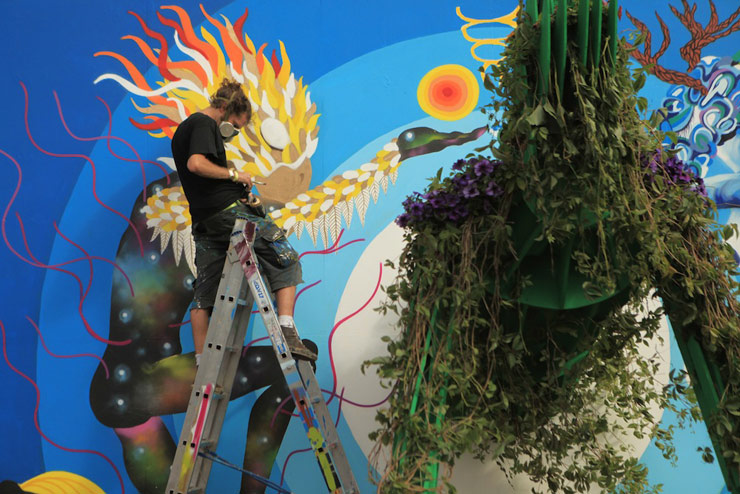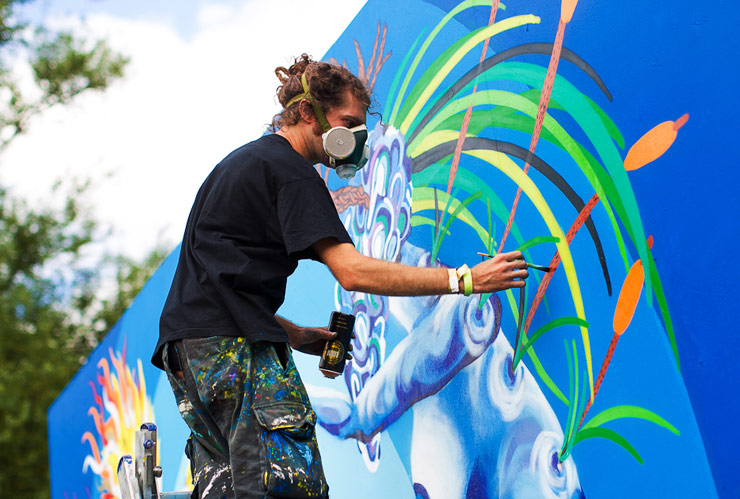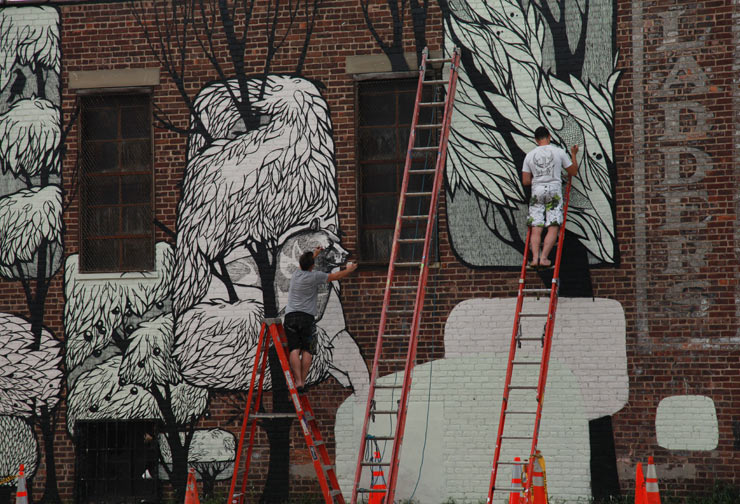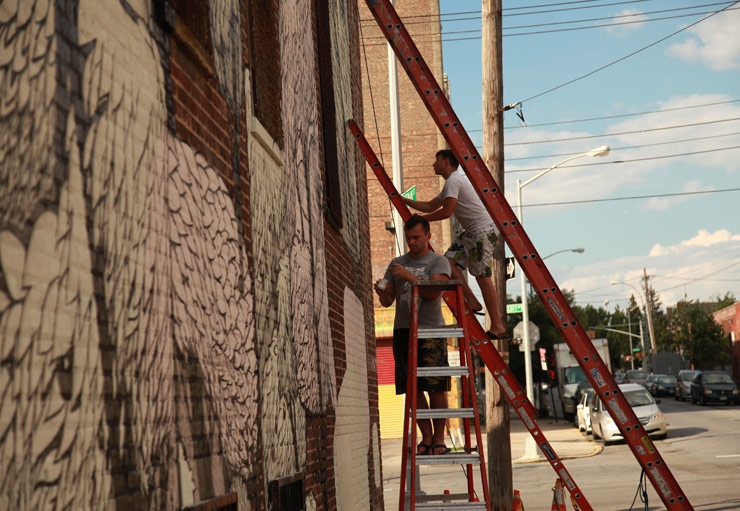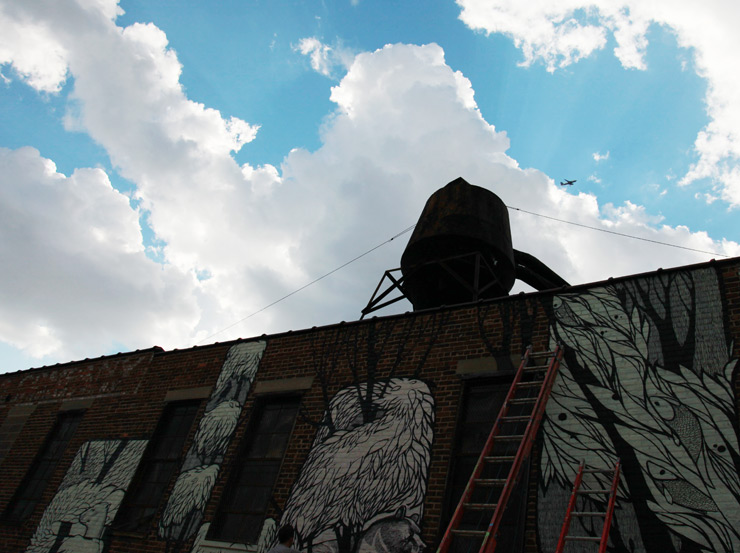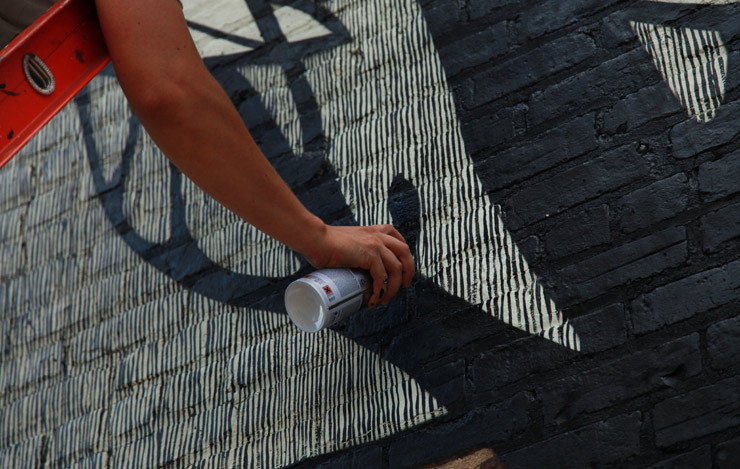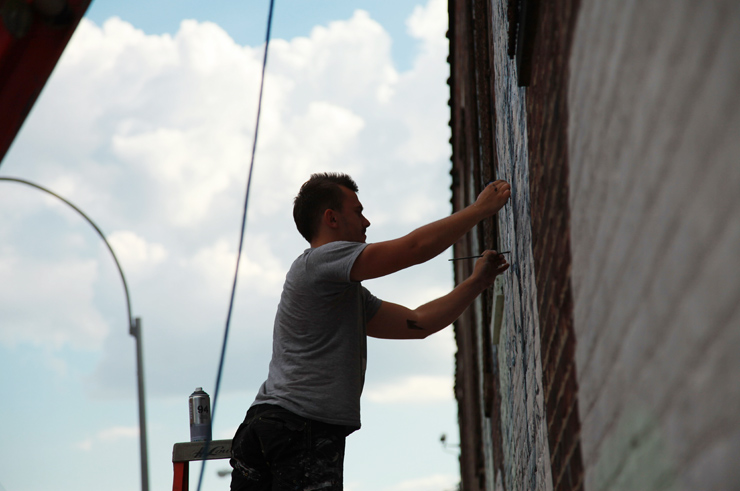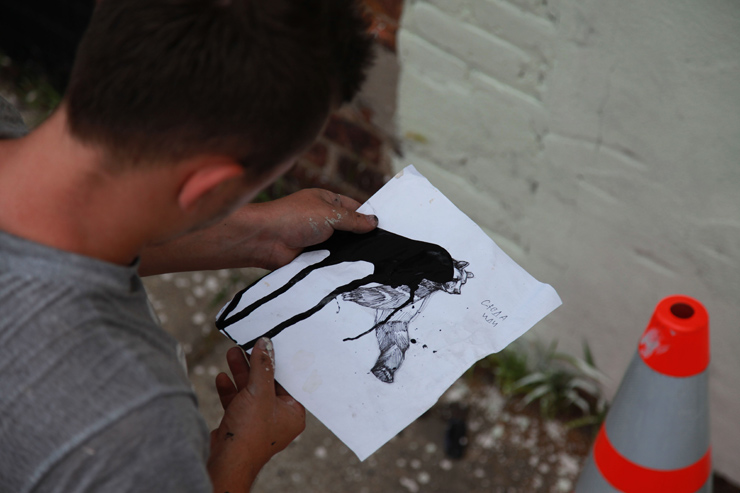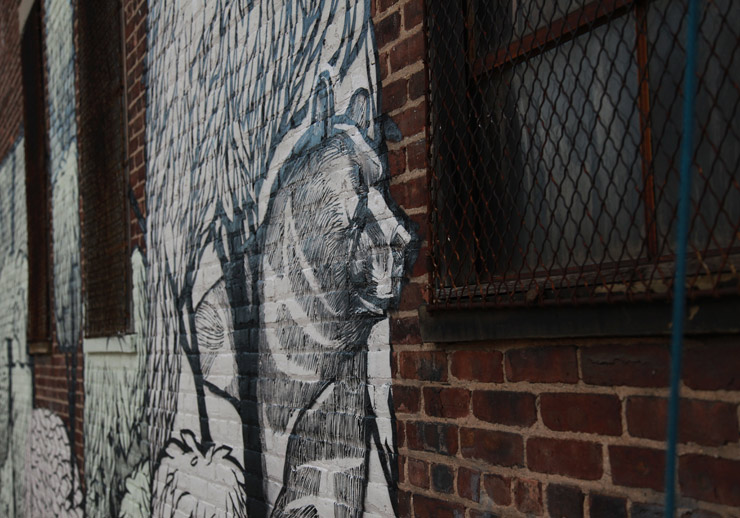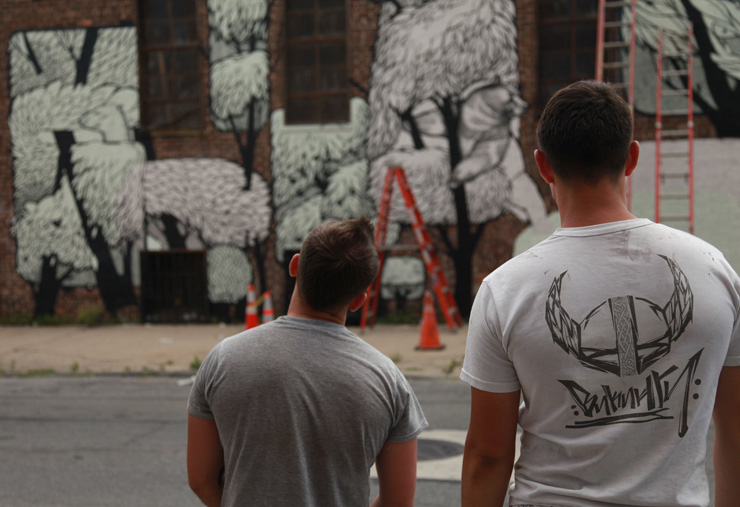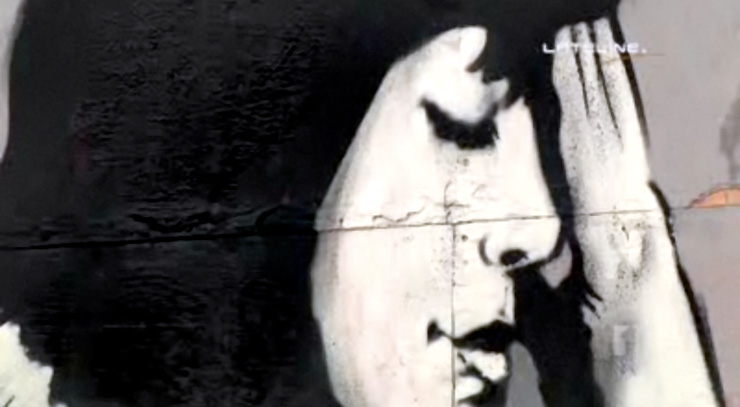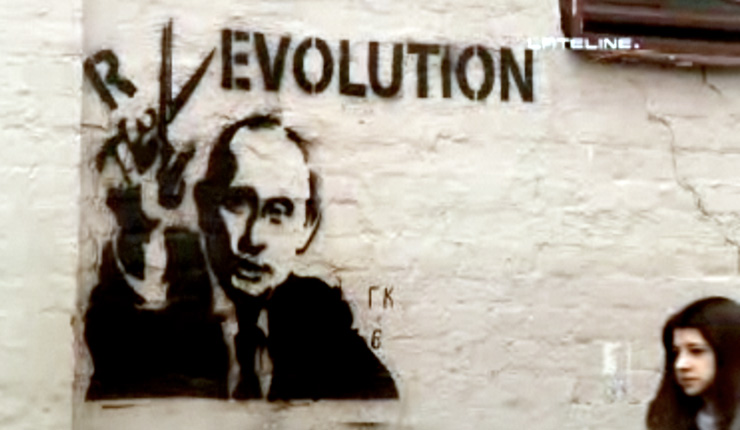Shortly before she left New York for Russia a couple of weeks ago to do an installation across the entrance of a shopping center with her signature camouflage crochet treatment, Street Artist Olek was feeling a bit nervous. Because of her Polish background and her regard for the Russian arts historically, she was excited to have an opportunity to create her handmade and storied personal art for the public sphere there. But due to Russia’s harshly homophobic atmosphere in recent years and the recent high profile anti-LGBT laws that reportedly have sparked a wave of new violence against gays and any of their supporters, the street artist questioned what her own role was and whether to show support through silence or with her creative voice.
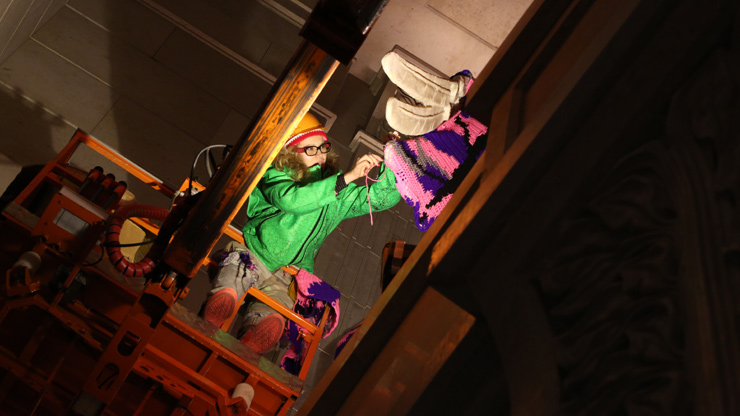
OLEK (photo © courtesy Olek)
Compounding those fears were the very ambiguous terms in the newly passed laws against “propaganda” that equates or encourages “nontraditional sexual relations” or “nontraditional sexual attitudes”.
Understandably, as an artist you may not want to address the topic at all – considering the jail time and fines threatened against foreigners. Not typically a wallflower, the fluorescent hued crochet queen eventually decided to go, and in the process addressed her opinions through a rainbow of camo, hoping to give a sense of hope, show some solidarity with the gay, lesbian, bisexual, transgender and queer folks in Russia who are currently oppressed in a somewhat muted, if deliberate, way.
Many who work in the arts prefer to keep them separate from politics, especially when the original piece was conceived in a different time in unrelated conditions and contexts. But pretending the resonance of a piece stands apart from its environment may be impossible. Just last night at Lincoln Center protesters disrupted a Russian themed opera to protest the new laws thousands of miles away and while some thought it appropriate, others, including the manager of the Metropolitan Opera, think political struggles should only be enacted on stage when the curtain goes up.
Street Art in recent years has veered toward the aesthetic and less overtly political according to some, but artists like Shepard Fairey have always considered it part of their remit to actively critique the society they live in and to advocate for change with their work on the street. In Olek’s case, this was more public art than street art, and commissioned work at that. Nonetheless, her description of her intent begs the question whether art can or should ever be considered without politics given its personal nature and our individual histories and cultural conditioning. Ultimately it will depend on the reaction of the audience, who Olek considers to be part of the art as well.
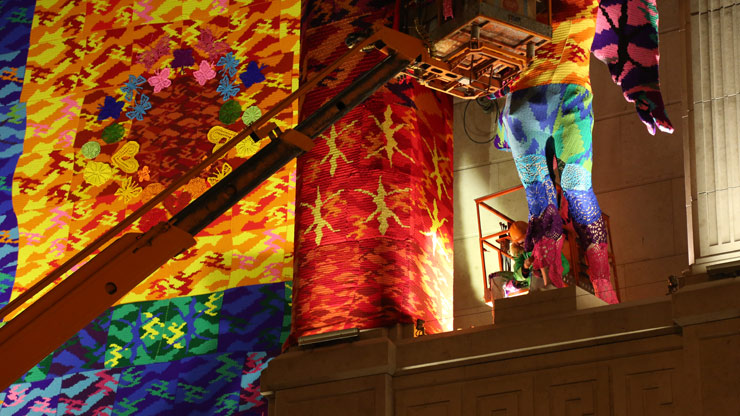
OLEK (photo © courtesy Olek)
Along with some exclusive images for BSA readers of the new installation and Olek at work, we had a chance to ask her a few questions about her perspective and her experience on this trip to Russia. Not surprisingly, she has plenty to say.
Brooklyn Street Art: How does this installation speak to a greater story about tolerance?
OLEK: The answer stems from how thoughts and ideas form themselves. I left Poland because of intolerance. People in Poland always pointed fingers and laughed at me merely because I wore colorful, hand-made, and vibrant clothes, because my expression of myself defied expectations. This is the main reason that in New York City I created the camouflage pattern. I transformed the human form into a new species. Once encapsulated in the hand-crocheted suit, you are a citizen of my world that doesn’t pay attention to skin, race, color, ethnicity or sexuality.
Inspiration also comes from life’s small details. Starting from 2002, I have crocheted everything from trees, to bicycles to a stepladder because my ex-girlfriend had one. Everything comes from real feelings, experiences and intuition. The public may not always know the background story, but they accept it or love my work because it is honest. I hope.
My installations are and have always been expressions of my responses to immediate surroundings, international climate, information, images, events in the news, emotions, words, lovers. These responses are what start the conversations that flow through my, and every individual’s, unconsciousness. Ideas are collaborations between environment and time. It is when these collaborations come to the surface that others decide to either accept and tolerate or to discriminate.
My recent work does not only focus on Russia’s suppression of the LGBT community. As I said in my statement to the Russian press, I support all people’s rights, our freedom to be whoever we want to be, who we truly are, to love whomever we choose and marry whomever we love.
I hope this installation encourages Russians and others who see my work elsewhere, to be more tolerant of others’ expressions of themselves. We still have a long way to go.
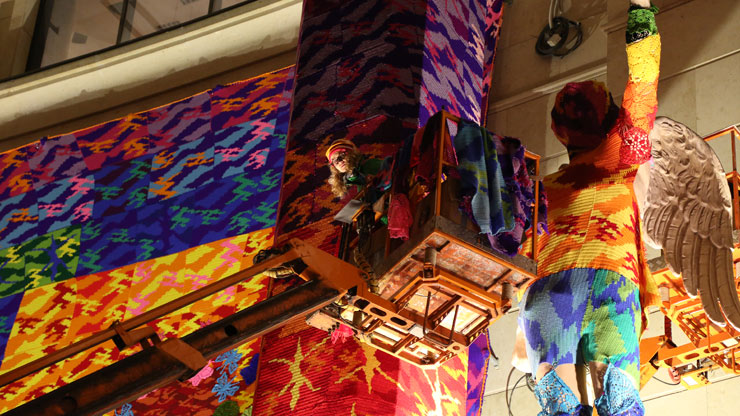
OLEK (photo © courtesy Olek)
Brooklyn Street Art: Did you feel conflicted about creating work as an artist in Russia?
OLEK: I really had a hard time making this journey. First of all because of personal experience and family history. Two years ago I was jailed in London for defending myself against the sexual aggression of a drunk Russian man. Also, my grandmother has recounted to me many stories about family members who were oppressed and jailed by the Soviet Union. Both of these experiences made a lasting impression on me.
Secondly, in response to Russia’s anti-gay law, many people around the world protested by dumping Russian vodka in the streets and by boycotting visits to Russia. Admirable, but I had already stopped drinking Russian vodka years ago. I also believed that it would be quite easy for me to boycott from afar. But what would it do for the LGBT community still in Russia? It would be much harder to actually cross the border and make my art in public to support those oppressed. Perhaps it would be a more powerful statement to stand within Russia and share my work in solidarity with those thousands who are stifled by this law. I wanted to bring colors. To inspire. To participate in the national culture by sparking dialogue with my art. I also decided, when asked by the press, to explain my personal philosophy, which sometimes is camouflaged by my colors and patterns. And although I was very afraid about being arrested or deported, I followed my intuition.
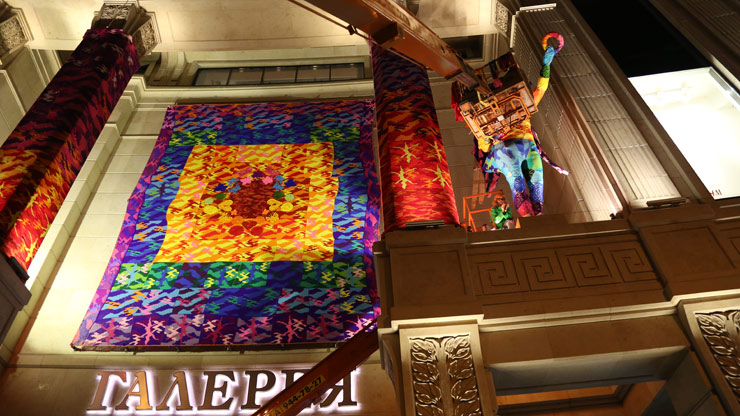
OLEK (photo © courtesy Olek)
Brooklyn Street Art: Would you consider this work a matter of exercising free speech? Art activism perhaps?
OLEK: I prefer making my art pieces and allowing others to judge, label, interpret, love or hate them. If you are saying that my work exercises free speech, I’ll give you a kiss.
Art can be subtler than a verbal or written statement, but it is still speech. So the ability to make a work of art uninhibited by fear, outdated laws, money or social pressure is absolutely an expression of free speech. We have seen over centuries of history art being censured for displaying accurate depictions of nudity, for incorporating subtle criticisms of religion and for displaying abstract concepts because of what they stood for.
Also when asked about my work I freely offer my own honest interpretation of and the inspirations, events and emotions that drove me to create my art in the particular way that I did. My “Injustice Everywhere is a Threat to Justice Anywhere” piece in London was my personal reflection on the justice system while I was awaiting sentencing. But more importantly, it spoke to something much bigger social reality.
Similarly, in this case, I did not hide my thoughts or beliefs in fear. So in a sense, my work and statement in St. Petersburg are both exercises of free speech because both are personal expressions of my convictions.
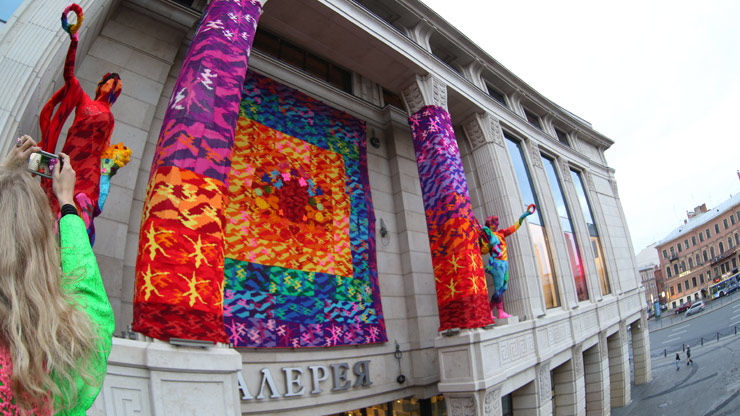
OLEK (photo © courtesy Olek)
Brooklyn Street Art: This was a commissioned work for commercial purposes originally, right?
OLEK: Yes. Around the time I was crocheting the camouflage rainbow train in Poland, Galeria, a large shopping center in St. Petersburg asked me to transform their incredibly complex façade. They chose my work based upon my previous installations and work. While I install much of my work “guerilla” style, I, like most artists, also work with galleries and private clients who sponsor installations and exhibitions.
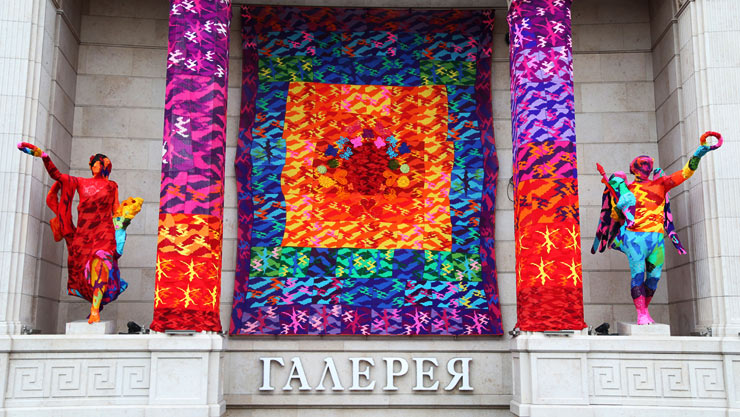
OLEK (photo © courtesy Olek)
Brooklyn Street Art: There is a misconception among some that if artwork is paid, it should be apolitical. Is that even possible?
OLEK: I really don’t know how artists (or authors or musicians for that matter) can separate themselves completely from expressing personal emotions, beliefs and convictions in their work. I believe that there are two main influences that should not dictate the way an artist makes art: money and public opinion. I believe in developing new ways of creating a dialogue with the viewer on both visual and aural levels. The audience’s senses heighten as they develop new means of interacting with the piece, realizing that their response greatly impacts the art and the ways these forms and colors are moving in time. Their response is also the art, and my work is a mirror. This reflection is very often political and cultural, regardless of whether I am paid or not.
I think there is often a misconception about my work because it is so bright and colorful. Often I think some believe that there is no underlying conceptual aspect to it. However, each of my works has a concept that it embodies. The colors, the shapes, the patterns – all have distinct, albeit at times discreet, theories and statements supporting my choices.
Brooklyn Street Art: Was there a reaction to your intended messages, or were they too camouflaged for most viewers to discern?
OLEK: With my actions I always intend to create a feedback to the economic and social reality in the community. In this case, I was very afraid that the authorities would not allow me to finish it because I was incorporating rainbows into the work. I experienced a very similar feeling to the one I had during my Wall Street Bull intervention – a sense of urgency pushing me to work at breakneck speed to complete my statement before being stopped. I just wanted to be able to finish the work regardless of public opinion or potential backlash or disfavor.
I experienced certain blindness while creating this piece. The first day, while working in the studio, I got many compliments about the colors. Then during the three long nights of installation, I observed odd expressions from bystanders. It was if they knew what the work stood for, as if they smelled it, but no one wanted to say it. Russia’s anti-gay law was enacted to prevent “propaganda of nontraditional sexual relations to minors”. But as usual, it was the small children in the street who first noticed and openly reacted to my work. Many of them ran to the performers in the crochet suits and embraced them without any inhibition or fear.
I should note that many open criticisms of my work came out of fear after the installation had been finished and I had interpreted the inspirations for my work in my own words. I think many times a percentage of the audience prefers to take the most palatable message from art without considering it more closely because it’s most comfortable and safe. When an artist then verbally contributes to that experience, it can upset that comfort.
To be honest though, any reaction is important. If at the end of the day, the audience just smiles and laughs, or turns on it in hate or chooses not to see it, they have contributed something to the work. It is the beauty of the public art. You might feel hidden in the crowd. But then, one person notices you.

OLEK (photo © courtesy Olek)
Read more of Olek’s personal account on her blog at The Huffington Post.
<<>>><><<>BSA<<>>><<<>><><BSA<<>>><><<>BSA<<>>><<<>><><BSA
Please note: All content including images and text are © BrooklynStreetArt.com, unless otherwise noted. We like sharing BSA content for non-commercial purposes as long as you credit the photographer(s) and BSA, include a link to the original article URL and do not remove the photographer’s name from the .jpg file. Otherwise, please refrain from re-posting. Thanks!
<<>>><><<>BSA<<>>><<<>><><BSA<<>>><><<>BSA<<>>><<<>><><BSA
 BROOKLYN STREET ART LOVES YOU MORE EVERY DAY
BROOKLYN STREET ART LOVES YOU MORE EVERY DAY